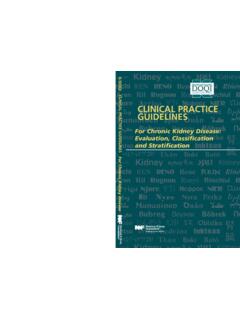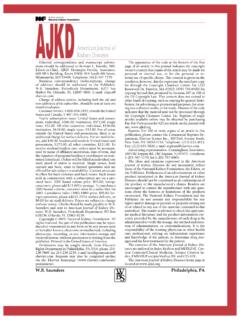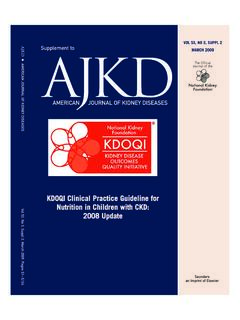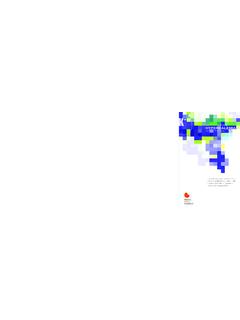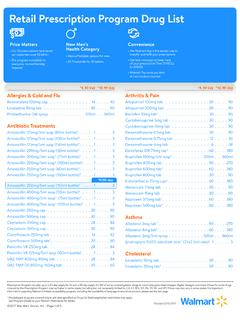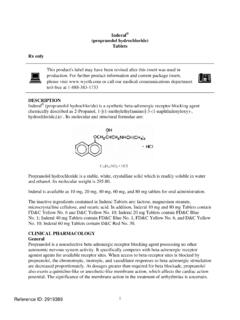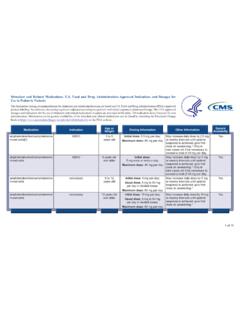Transcription of FREQUENTLY ASKED QUESTIONS ABOUT GFR ESTIMATES
1 FREQUENTLY ASKED QUESTIONS ABOUT GFR Estimates3 FREQUENTLY ASKED QUESTIONS ABOUT GFR ESTIMATESTABLE OF CONTENTSASSESSMENT OF KIDNEY FUNCTION ..41] What is GFR? ..42] Why assess GFR as an index of kidney function? ..43] How does age affect GFR in adults? ..44] How is GFR assessed? ..45] What is a filtration marker? ..46] Why is GFR indexed for body surface area? ..57] How is the accuracy of the GFR assessments described? 58] How is GFR measured? ..59] How is GFR estimated? ..510] What problems are caused by the non-steady state of endogenous filtration markers after a change in GFR? .611] What is the recommended approach for evaluation of GFR? ..612] What is creatinine and how is serum creatinine used in creatinine-based GFR estimating equations (eGFRcr)? ..613] Can serum creatinine be used alone for GFR estimation? 714] What is the difference between creatinine clearance and GFR? ..715] What is the currently recommended equation to estimate GFR from serum creatinine?
2 716] What is the Cockcroft-Gault formula? ..817] What is the MDRD Study equation? ..818] What is the 2009 CKD-EPI creatinine equation? ..819] Why was the CKD-EPI creatinine equation revised in 2021? ..920] What is the difference in eGFRcr using the 2021 versus the 2009 equation? ..1021] Should clinical laboratories report eGFR when Scr is measured? ..1022] Should clinical laboratories that use the MDRD Study equation for GFR reporting also change to the 2021 CKD-EPI creatinine equation? ..1023] Why might different laboratories or health systems report different eGFR for the same patient? ..1024] Are calculators available for the CKD-EPI creatinine, MDRD Study, or Cockcroft-Gault equations? ..1125] What factors affect creatinine generation? ..1126] What factors affect creatinine secretion? ..1127] What is the impact of calibration and inter-laboratory variation of serum creatinine assays on the estimation of GFR? ..1128] What factors affect the creatinine assays?
3 1229] What was the effect of standardization of the creatinine assay on GFR ESTIMATES ?..1230] What are indications for confirmation of eGFRcr? ..1231] What is cystatin C and how is serum cystatin C used in cystatin C-based GFR estimating equations (eGFRcys)? ..1232] Is cystatin C a more accurate filtration marker than creatinine? ..1333] Can serum cystatin C (Scys) be used alone for GFR estimation? ..1334] What is the currently recommended equation to estimate GFR from serum cystatin C? ..1335] Why is eGFRcr-cys more accurate than either eGFRcr or eGFRcys? ..1336] Cystatin C and risk ..1437] When should cystatin C be measured? ..14 INTERPRETATION OF GFR ESTIMATES ..1538] How should differences in a patient s eGFR be interpreted during the transition from the old to the new equations? ..1539] To which populations or individuals do the CKD-EPI 2021 equations not apply? ..1540] Why is the Cockcroft-Gault equation still used, even though it is less accurate?.
4 1541] How should GFR ESTIMATES be used to detect CKD? ..1542] How can GFR ESTIMATES be used to detect progression? 1643] Do some drugs affect the accuracy of GFR ESTIMATES ? ..1644] Should indexed or non-indexed eGFR be used when dosing medications? ..1645] Can the estimating equations for GFR be used in acute kidney injury? ..1646] Can GFR ESTIMATES be used in hospitalized patients?..16 CHRONIC KIDNEY DISEASE ..1747] What is the public health problem associated with CKD? 1748] What is the definition of CKD and how is GFR used as a criterion for CKD? ..1749] What are the stages of CKD? ..1850] What are markers of kidney damage? ..1851] What is the recommended method to screen for albuminuria or proteinuria? ..1852] What are the complications and common comorbidities associated with CKD?..1953] Does the risk of complications increase as kidney disease progresses? ..1954] When should patients with kidney disease be referred to a nephrologist? ..19 BIBLIOGRAPHY.
5 20 CHRONIC KIDNEY DISEASEBIBLIOGRAPHYASSESSMENT OF KIDNEY FUNCTIONINTERPRETATION OF GFR ESTIMATES4 NATIONAL KIDNEY FOUNDATION ASSESSMENT OF KIDNEY FUNCTIONASSESSMENT OF KIDNEY FUNCTION1] What is GFR?GFR (glomerular filtration rate) is equal to the total of the filtration rates of the functioning nephrons in the kidney. GFR is considered the most useful index of kidney function in health and disease, which in conjunction with albumin-uria, generally assessed from urine albumin-to-creatinine ratio (uACR), can help determine the presence and severity of chronic kidney disease (CKD).2] Why assess GFR as an index of kidney function?GFR is considered the best index of kidney function in health and disease. The level of GFR and its magnitude of change over time are important to: Detect CKD Understand the severity or stage of CKD Make decisions ABOUT diagnosis, prognosis, and treatment of GFR varies according to age, sex, and body size; in young adults, it is approximately 120 mL/ m2 and declines with age.
6 A decrease in GFR precedes the onset of kidney failure. Therefore, a persistently reduced GFR is a specific diagnostic criterion for CKD. Below 60 mL/ m2, the prevalence of complications of CKD increases, as does the risk of cardiovascular disease (CVD).Table 1 lists clinical conditions where assessment of GFR is ] How does age affect GFR in adults?GFR generally declines with age. However, there appears to be substantial variation among individuals, and reasons for decline are not completely known (healthy aging, disease, or other factors). The threshold to diagnose CKD does not differ by age. At all ages, GFR is an independent predictor of adverse outcomes, such as death, cardiovas-cular disease, and other CKD complications. In addition, decreased GFR in the elderly may require adjustment in drug dosages, as with younger patients with decreased GFR. Some have proposed age-stratified GFR criteria for the diagnosis of ] How is GFR assessed?GFR cannot be measured directly.
7 It can be assessed as measured (mGFR) or estimated (eGFR) from the clearance or serum (plasma) concentration of a filtration marker, ] What is a filtration marker?Filtration markers are exogenous or endogenous solutes with molecular weight less than approximately 20,000 Daltons whose serum concentration varies inversely with GFR and can be used to measure or estimate GFR. An ideal filtration marker is freely filtered by the glomeruli (not protein-bound), is not reabsorbed or secreted by the tubules, does not affect kidney function, and is easy to measure. Exogenous filtration markers include inulin (the gold standard), iothalamate, iohexol, EDTA, DTPA, and synthetic polymers. Endogenous filtration markers include TABLE 1: CLINICAL CONDITIONS WHERE ASSESSMENT OF GFR IS IMPORTANT*CLINICAL DECISIONSCURRENT LEVEL OF GFRCHANGE IN LEVEL OF GFRD iagnosis Detection of CKD Evaluation for kidney donation Detection of AKI Detection of CKD progressionPrognosis Risk of CKD complications Risk for CVD Risk for mortality Risk for kidney failureTreatment dosage and monitoring for medications cleared by the kidney Determine safety of diagnostic tests or procedures Referral to nephrologists Referral for kidney transplantation Placement of dialysis access Treatment of AKI Monitoring drug toxicityAbbreviations: AKI: acute kidney injury; CKD: chronic kidney disease; CVD: cardiovascular disease.
8 *Reprinted with permission from the American Society of Nephrology via the Copyright Clearance Center. Stevens LA, Levey AS. J Am Soc Nephrol. 2009;20:2305 ASKED QUESTIONS ABOUT GFR ESTIMATESASSESSMENT OF KIDNEY FUNCTION metabolites (creatinine is most commonly used) and low molecular weight proteins (cystatin C, beta-2 microglobulin, and beta-trace protein).6] Why is GFR indexed for body surface area?Kidney function is proportional to kidney size, which is proportional to body surface area (BSA). Adjustment for BSA is necessary when comparing a person s GFR to normal values, to the GFR criterion for the diagnosis of CKD, and to levels defining the stages of CKD. A BSA of m2 was the normal mean value for young adults when indexing was proposed. BSA can be computed using the formula of DuBois and DuBois. BSA (m2)= x x (where height is measured in centimeters, and weight in kilograms)Indexed GFR is less than non-indexed GFR in people with large BSA (tall or obese) and greater than non-indexed GFR in people with small BSA (short or very thin).
9 Indexed GFR may be converted to non-indexed GFR by the formula:non-indexed GFR= indexed GFR x BSA (m2) m27] How is the accuracy of the GFR assessments described?Errors in diagnostic tests can arise from systematic error (bias, average difference from the reference or gold stan-dard) or random error (imprecision, variability of the differ-ences ABOUT the average difference). Accuracy reflects a combination of absence of bias ( trueness ) and precision; there are many metrics for describing accuracy. Common metrics for describing accuracy of GFR assessments are bias (mean or median difference) on the GFR scale (a lower value is more accurate), and the proportion of assessments that are within a specified percentage of the reference standard (for example, within 15% or 30%, a higher value is more accurate, see below).8] How is GFR measured?Measured GFR (mGFR) is determined from the urinary or plasma clearance of an exogenous filtration marker. However, these procedures are cumbersome and not used in routine clinical practice but may be used as confirma-tory tests in special circumstances and in research studies.
10 Urinary clearance of inulin during a continuous infusion is the classic method of Homer Smith. This procedure has limited precision; only approximately 90% of repeated measurements are within 15% of the initial measurement (P15= 90%). This mGFR procedure is rarely used, even in research studies. The following alternative clearance methods and filtration markers had strong to moderate evidence of accuracy compared to the classic method: urinary clearance of iothalamate, plasma clearance of iohexol, and urinary and plasma clearance of Cr-EDTA (not available in US). In general, plasma clearance methods have greater precision than urinary clearance methods. Special circumstances in which mGFR may be necessary in selected cases for clinical practice decision making include the assessment of a potential living kidney donor and infre-quently for medication dosing for critical patients in whom a measured GFRshould be DETERMINANTS OFSERUM LEVELS OFENDOGENOUS FILTRATIONMARKERSG eneration, renal excretion (filtration,secretion, and reabsorption), and ex-trarenal elimination determine serumlevels of endogenous filtration markers(Figure 1).
